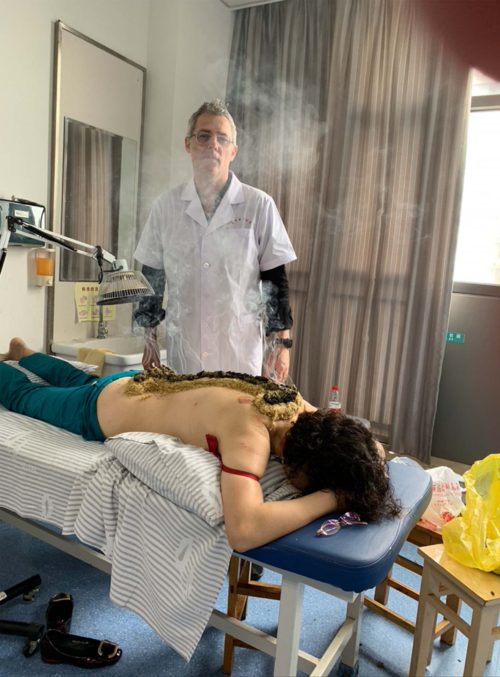Raynaud’s phenomenon is caused by episodic vasospasm and ischemia of the extremities (especially the fingers and toes) in response to a fall in temperature (even taking a cold milk bottle out of the fridge or a cool wind on a hot beach (RSA 2012)) or an emotional stimulus.(Goundry 2012) This response results in a characteristic color change in the extremities from white, to blue, to red. In about 89% of people, Raynaud’s occurs in direct response to a stimulus and there is no known underlying cause. In the other 11%, it results from an underlying condition, most commonly a connective tissue disease such as systemic sclerosis, mixed connective tissue disease.(Goundry 2012)

Patient receiving warming treatment of ginger and moxibustion to warm kidney yang and tonify the immune system
Prevalence and Causes of Raynaud’s Phenomenon
Studies report 3–12.5% of men and 6–20% of women experience Raynaud’s phenomenon symptoms (Fraenkel, 2002). Prevalence varies across countries, increasing in colder climates. In women, family history, estrogen exposure, and emotional stress often contribute (Fraenkel, 2002). Conversely, smoking and hand-arm vibration syndrome frequently affect men (RSA, 2012; Palmer, 2000).
Conventional Treatments
Few treatments exist for Raynaud’s. Lifestyle changes, like exercising regularly, quitting smoking, and avoiding triggers such as cold or stress, help manage symptoms. In the UK, Nifedipine remains the only licensed drug, though others are under study. Rarely, surgery becomes necessary.
Acupuncture’s Role
The resulting biochemical changes influence the body’s homeostatic mechanisms, thus promoting physical and emotional well-being.
Research has shown that acupuncture treatment may specifically help to relieve the symptoms of Raynaud’s by:
– Increasing local microcirculation (Komori 2009);- Regulating endothelium-derived vasoconstrictors (endothelin-1) and vasodilators (calcitonin gene-related peptide, nitric oxide, and nitric oxide synthase) (Wang 2011a; Wang 2011b; Pan 2010; Kim 2006);- Reducing inflammation, by promoting the release of vascular and immunomodulatory factors (Kavoussi 2007)
Acting on areas of the brain known to reduce sensitivity to pain and stress, as well as promoting relaxation and deactivating the ‘analytical’ brain, which is responsible for anxiety and worry (Hui 2010; Hui 2009);
– Increasing the release of adenosine, which has antinociceptive properties (Goldman 2010).
Resources:
– SOURCE: Fraenkel L. Raynaud’s phenomenon: epidemiology and risk factors. Curr Rheumatol Rep 2002; 4: 123-8. Goundry B et al. Diagnosis and management of Raynaud’s phenomenon, BMJ 2012; 344: e289 doi: 10.1136/bmj.e289 Palmer K et al. Prevalence of Raynaud’s phenomenon in Great Britain and its relation to hand transmitted vibration: a national postal survey. Occup Environ Med 2000; 57: 448-52.
http://www.acupuncture.org.uk/index.php?option=com_k2&view=item&id=1920:…